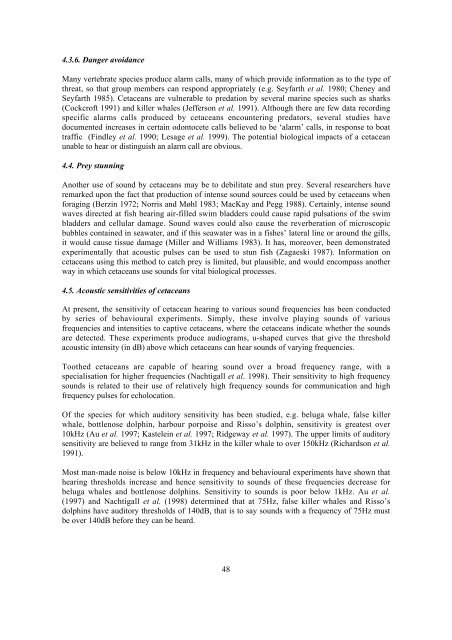Oceans of noise - Whale and Dolphin Conservation Society
Oceans of noise - Whale and Dolphin Conservation Society
Oceans of noise - Whale and Dolphin Conservation Society
- No tags were found...
Create successful ePaper yourself
Turn your PDF publications into a flip-book with our unique Google optimized e-Paper software.
4.3.6. Danger avoidanceMany vertebrate species produce alarm calls, many <strong>of</strong> which provide information as to the type <strong>of</strong>threat, so that group members can respond appropriately (e.g. Seyfarth et al. 1980; Cheney <strong>and</strong>Seyfarth 1985). Cetaceans are vulnerable to predation by several marine species such as sharks(Cockcr<strong>of</strong>t 1991) <strong>and</strong> killer whales (Jefferson et al. 1991). Although there are few data recordingspecific alarms calls produced by cetaceans encountering predators, several studies havedocumented increases in certain odontocete calls believed to be ‘alarm’ calls, in response to boattraffic (Findley et al. 1990; Lesage et al. 1999). The potential biological impacts <strong>of</strong> a cetaceanunable to hear or distinguish an alarm call are obvious.4.4. Prey stunningAnother use <strong>of</strong> sound by cetaceans may be to debilitate <strong>and</strong> stun prey. Several researchers haveremarked upon the fact that production <strong>of</strong> intense sound sources could be used by cetaceans whenforaging (Berzin 1972; Norris <strong>and</strong> Møhl 1983; MacKay <strong>and</strong> Pegg 1988). Certainly, intense soundwaves directed at fish bearing air-filled swim bladders could cause rapid pulsations <strong>of</strong> the swimbladders <strong>and</strong> cellular damage. Sound waves could also cause the reverberation <strong>of</strong> microscopicbubbles contained in seawater, <strong>and</strong> if this seawater was in a fishes’ lateral line or around the gills,it would cause tissue damage (Miller <strong>and</strong> Williams 1983). It has, moreover, been demonstratedexperimentally that acoustic pulses can be used to stun fish (Zagaeski 1987). Information oncetaceans using this method to catch prey is limited, but plausible, <strong>and</strong> would encompass anotherway in which cetaceans use sounds for vital biological processes.4.5. Acoustic sensitivities <strong>of</strong> cetaceansAt present, the sensitivity <strong>of</strong> cetacean hearing to various sound frequencies has been conductedby series <strong>of</strong> behavioural experiments. Simply, these involve playing sounds <strong>of</strong> variousfrequencies <strong>and</strong> intensities to captive cetaceans, where the cetaceans indicate whether the soundsare detected. These experiments produce audiograms, u-shaped curves that give the thresholdacoustic intensity (in dB) above which cetaceans can hear sounds <strong>of</strong> varying frequencies.Toothed cetaceans are capable <strong>of</strong> hearing sound over a broad frequency range, with aspecialisation for higher frequencies (Nachtigall et al. 1998). Their sensitivity to high frequencysounds is related to their use <strong>of</strong> relatively high frequency sounds for communication <strong>and</strong> highfrequency pulses for echolocation.Of the species for which auditory sensitivity has been studied, e.g. beluga whale, false killerwhale, bottlenose dolphin, harbour porpoise <strong>and</strong> Risso’s dolphin, sensitivity is greatest over10kHz (Au et al. 1997; Kastelein et al. 1997; Ridgeway et al. 1997). The upper limits <strong>of</strong> auditorysensitivity are believed to range from 31kHz in the killer whale to over 150kHz (Richardson et al.1991).Most man-made <strong>noise</strong> is below 10kHz in frequency <strong>and</strong> behavioural experiments have shown thathearing thresholds increase <strong>and</strong> hence sensitivity to sounds <strong>of</strong> these frequencies decrease forbeluga whales <strong>and</strong> bottlenose dolphins. Sensitivity to sounds is poor below 1kHz. Au et al.(1997) <strong>and</strong> Nachtigall et al. (1998) determined that at 75Hz, false killer whales <strong>and</strong> Risso’sdolphins have auditory thresholds <strong>of</strong> 140dB, that is to say sounds with a frequency <strong>of</strong> 75Hz mustbe over 140dB before they can be heard.48




